 The Grand Alpaca Farm is opening its gates to anyone who’s interested in learning more about Alpacas. The invitation recognizes National Alpaca Farm Days.
The Grand Alpaca Farm is opening its gates to anyone who’s interested in learning more about Alpacas. The invitation recognizes National Alpaca Farm Days.
Tim Talbott saw a news story in 1984, about Americans importing alpacas from South America and raising them for their cashmere-like fiber. Intrigued, the established surgeon sought more information. In 1985, he and his wife, Jane, invested in six alpacas and made a long-range business plan to increase the herd to 100 animals by the time he retired. Dr. Talbott, who recently retired, has more than met his goal. “We have more than 100 Chilean and Peruvian Huacaya alpacas – the largest herd in Michigan,” he says. “And although we started raising and selling alpacas as an investment 22 years ago, we enjoy them more each year.”
An alpaca, cousin to the Llama and a member of the Camelid family, is about 36 inches tall, weighs about 150 pounds fully grown and can live up to 20-25 years. Tim says, “Because of their manageable size and calm dispositions, they make wonderful companion animals and are very gentle with children … making them ideal for families.”
The Talbotts, early pioneers in the alpaca industry, and one of the founding members of the national organization, the Alpaca Owners and Breeders Association, take pride in the history they have in the alpaca business, the quality of alpacas they sell, and the level of service they provide. Their alpacas are fully guaranteed ARI registered alpacas that are personally raised and managed by Tim and Jane.
When the Talbotts purchased their six alpacas in 1985, there were about 350 alpacas in North America. Today, there are about 100,000 alpacas. The reason for such growth is simple; “People recognize the many benefits of alpaca ownership,” according to Tim.
Now Tim and Jane wish to share their enthusiasm with others during National Alpaca Farm Days. “We invite anyone interested in raising alpacas or are just curious about the animals to come, tour the farm and meet our alpacas,” Jane says.
The Grand Alpaca Farm, 4344 Four Mile Road, N.W., will be open to the public Saturday, September 29 and Sunday the 30th from 10:00 A.M. to 4:00 P.M.
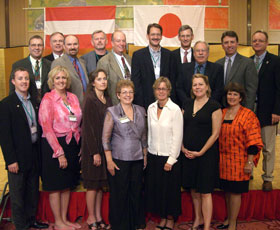 Here’s a fine looking group of Americans don’t you think?
Here’s a fine looking group of Americans don’t you think?


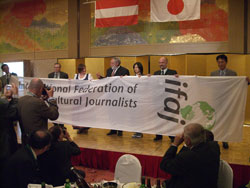 The IFAJ Congress is over and we’re about to head on out for the long trek home. Here’s the ceremonial passing of the IFAJ flag from the Japanese to the Austrians.
The IFAJ Congress is over and we’re about to head on out for the long trek home. Here’s the ceremonial passing of the IFAJ flag from the Japanese to the Austrians.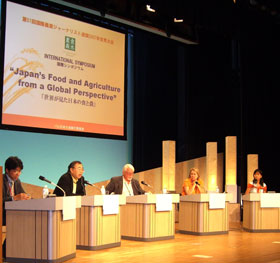 Today we had a free morning to shop or just plain relax here in Sendai. Our IFAJ Congress is coming to a close with tonight’s final reception. I’ll have some more posting to do which might have to wait until I’m home. Tomorrow is a travel day. The photo album is up to date though.
Today we had a free morning to shop or just plain relax here in Sendai. Our IFAJ Congress is coming to a close with tonight’s final reception. I’ll have some more posting to do which might have to wait until I’m home. Tomorrow is a travel day. The photo album is up to date though. Inventive ag producers have come up with yet another way to use corn in an eco-friendly way. Dupont and Tate & Lyle are now offering corn-based deodorants.
Inventive ag producers have come up with yet another way to use corn in an eco-friendly way. Dupont and Tate & Lyle are now offering corn-based deodorants. The United Nations has recognized
The United Nations has recognized 
 A million dollar pledge from
A million dollar pledge from 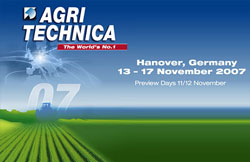 Chuck and Cindy have been providing international ag coverage for the past several weeks, and in November, it will be my turn. I’m planning to join
Chuck and Cindy have been providing international ag coverage for the past several weeks, and in November, it will be my turn. I’m planning to join 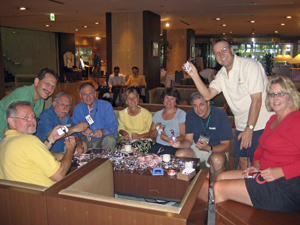 Here is our group from the United States at the IFAJ Congress in the lobby of the Sendai Excel Hotel doing some arts and crafts.
Here is our group from the United States at the IFAJ Congress in the lobby of the Sendai Excel Hotel doing some arts and crafts.  A couple of consultants from Elanco Animal Health have moved up in ranks. Dr. Bill Platter oversees consultants for beef cattle and Dr. Bill Mies is Elanco’s latest beef consultant.
A couple of consultants from Elanco Animal Health have moved up in ranks. Dr. Bill Platter oversees consultants for beef cattle and Dr. Bill Mies is Elanco’s latest beef consultant.